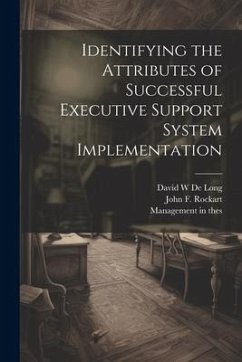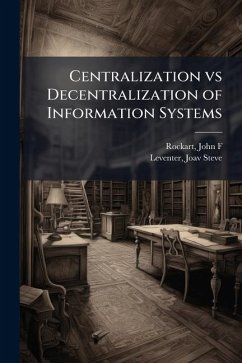
A System Dynamics Approach for Information Technology Implementation and Sustainment
Versandkostenfrei!
Versandfertig in über 4 Wochen
22,99 €
inkl. MwSt.
Weitere Ausgaben:

PAYBACK Punkte
11 °P sammeln!
The goal of this research is to bring a new, dynamic modeling perspective to organizational information technology (IT) implementation systems (using the Air Force GeoBase initiative as a real-world example) without compromising principles from the research literature. Undesired behavior patterns, from historically poor IT implementation performance, versus desired behavior patterns are incorporated into the model structure. Using a system dynamics approach, multiple simulation runs under various initial conditions and organizational contexts are performed and compared over a short-term versus...
The goal of this research is to bring a new, dynamic modeling perspective to organizational information technology (IT) implementation systems (using the Air Force GeoBase initiative as a real-world example) without compromising principles from the research literature. Undesired behavior patterns, from historically poor IT implementation performance, versus desired behavior patterns are incorporated into the model structure. Using a system dynamics approach, multiple simulation runs under various initial conditions and organizational contexts are performed and compared over a short-term versus a long-term period of time. Based on these simulation runs, various mixes of management interventions, under varying conditions, are recommended to improve IT implementation performance based on manager and organizational goals. Generally, for better long-term system performance, learning management, with a focus on team learning, is the best single IT implementation tool. With a low level of organizational buy-in at the beginning of the IT implementation effort, change process management should be the initial focus of management effort. Reward system management provides a short-term spark, but its implementation effects are not carried over for long-term sustainment as readily as learning management or change process management. Continuity management, though beneficial, does not provide as much "bang for the buck" as the other management interventions. This work has been selected by scholars as being culturally important, and is part of the knowledge base of civilization as we know it. This work was reproduced from the original artifact, and remains as true to the original work as possible. Therefore, you will see the original copyright references, library stamps (as most of these works have been housed in our most important libraries around the world), and other notations in the work. This work is in the public domain in the United States of America, and possibly other nations. Within the United States, you may freely copy and distribute this work, as no entity (individual or corporate) has a copyright on the body of the work. As a reproduction of a historical artifact, this work may contain missing or blurred pages, poor pictures, errant marks, etc. Scholars believe, and we concur, that this work is important enough to be preserved, reproduced, and made generally available to the public. We appreciate your support of the preservation process, and thank you for being an important part of keeping this knowledge alive and relevant.












